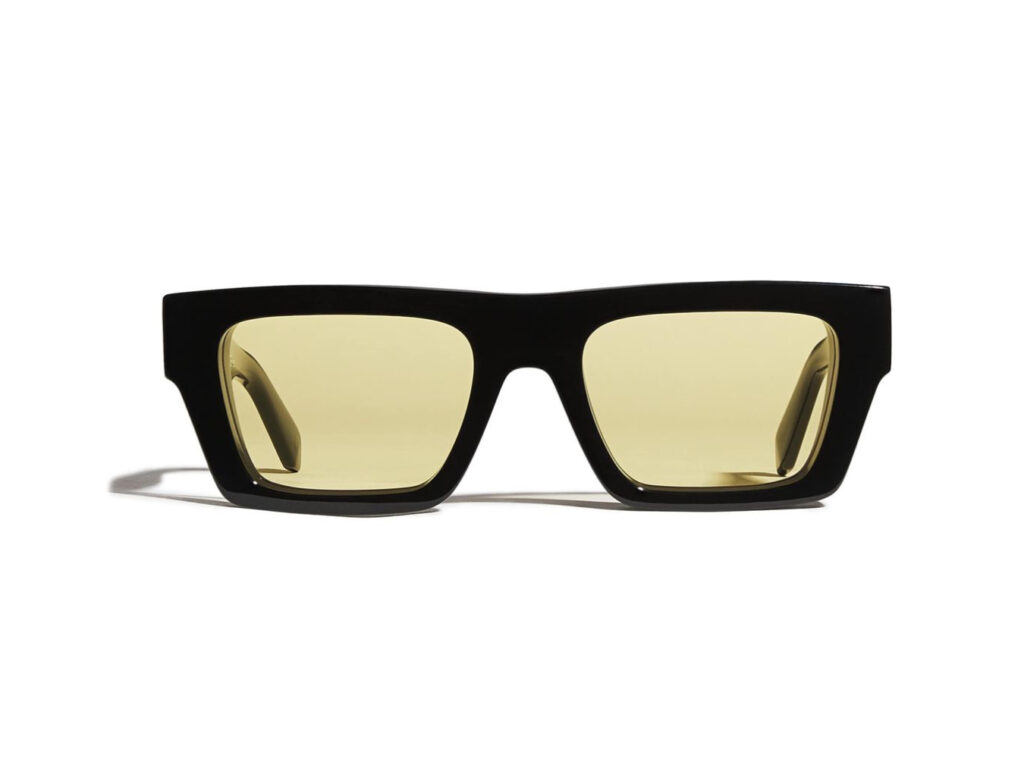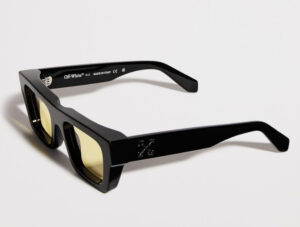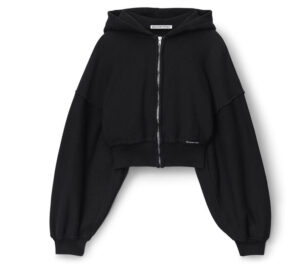When Virgil Abloh created Off-White™ c/o Virgil Abloh, he didn’t just build a fashion label—he drafted a cultural syllabus. Every garment, runway, and product drop was a footnote in a much larger thesis about identity, irony, status, and perception. That thesis extended far beyond clothing. Among the brand’s most symbolically rich yet functionally sharp pieces are its sunglasses—design objects that reflect Abloh’s postmodern playbook while delivering real-world utility.
Off-White™ sunglasses are not merely accessories. They’re framing devices—both literally and metaphorically. They shield the eyes while revealing an attitude. They riff on industrial design tropes, nod to subcultural silhouettes, and always carry a trace of Abloh’s signature codes: quotation marks, architectural line work, and logos that are both hyper-visible and deeply referential.
Between Shade and Statement: The Function of Form
In Off-White’s eyewear line, function and philosophy are inseparable. The frames often appear familiar at first glance—oversized aviators, rectangular wraparounds, bug-eye futurism—but closer inspection reveals intentional distortion. Some frames are contoured at odd angles. Others wrap around the temples like hardware. The lenses? Sometimes transparent, sometimes opaque, occasionally mirrored, always intentional.
Off-White doesn’t sell sunglasses to hide—it sells them to amplify. The silhouettes are bold, sometimes brash, sometimes playful, often unorthodox. Think chunky acetate in high-contrast tones, or rimless lenses bolted to floating frames, or the more recent sculptural steel bridge series that recall Bauhaus objects as much as they do music video props.
Quotation Marks and Optical Irony
Perhaps no detail embodies Virgil’s influence more than the infamous quotation marks. “SUNGLASSES.” A phrase printed on the lens or temple arm. That period at the end? It’s a signature. And it’s more than a joke. It’s a meta-commentary—a way of naming the object while also questioning its meaning.
This device, borrowed from conceptual artists like Joseph Kosuth and Barbara Kruger, turns the accessory into a piece of commentary. “SUNGLASSES” isn’t just text—it’s Abloh reminding you that everything we consume, wear, or covet is a construct. These are not simply fashion items. They’re readymades. Provocations. Labels on labels.
Design Codes: Diagonals, Arrows, and Typography
Beyond the quotation marks, Off-White eyewear makes use of the brand’s evolving iconography. The crossed arrows logo often appears subtly engraved or heat-printed on the temple tip. In other models, the diagonal stripes function as lens etchings or form part of the temple structure, nodding to caution tape and industrial signage.
Typefaces matter, too. Off-White eyewear integrates its own custom Helvetica variant, designed to sit uncomfortably close to corporate branding—but warped just enough to feel off-kilter. It’s brand identity as both surface design and critique.
These details are never ornamental. They’re about tension: between luxury and accessibility, between corporate and anti-corporate, between anonymity and hyper-visibility.
Cultural Alignment: From Runway to Rap Videos
Off-White sunglasses don’t live quietly. They appear in music videos, on NBA tunnels, in editorials, and on the streets of Tokyo, Paris, and Brooklyn. Everyone from A$AP Rocky to Rosalía, Skepta to LeBron James, has worn them—not just as protective eyewear, but as symbols of status and subcultural fluency.
The connection with hip-hop and skate culture isn’t accidental. Virgil came up alongside Kanye West, DJ’d under the name Flat White, and often referred to rap as his fashion school. Off-White shades are worn the same way a vintage Raf Simons parka might be worn—with irony, authority, and an eye toward the archive.
Manufacturing Excellence: Built Like Architecture
Although Off-White sunglasses play with irony and language, their construction is deadly serious. Many of the frames are produced in collaboration with luxury Italian eyewear manufacturers, known for their precision mold work, lightweight materials, and cutting-edge lens technology.
Frames use acetate and stainless steel, often sculpted via CNC machining or 3D-modeling. The lenses feature anti-scratch coatings, UVA/UVB filters, and sometimes photochromic tints that change under different lighting. Hinges are spring-loaded for longevity, and temple tips are often rubberized for secure grip. These aren’t props—they’re technically refined tools, camouflaged in a conceptual language.
Notable Models: The Must-Know Drops
A few standout Off-White sunglasses deserve special mention:
- Virgil 1.0: An oversized aviator style with etched “SUNGLASSES” text and contrast temple hardware. Worn by Gigi Hadid and Burna Boy.
- The Hyperspace Wrap: A rimless wraparound model in mirrored orange, influenced by 2000s motocross goggles.
- Arrow Shield: A flat-top model with bold gradient lens, bearing the Off-White arrow logo across the bridge.
- Studio Series: Minimalist stainless steel wireframes designed for low-light city use—one of the most technically refined collections to date.
Each model functions as a visual essay—a meditation on speed, surveillance, sport, and spectacle.
Virgil’s Absence, the Brand’s Evolution
Since Virgil’s passing in 2021, Off-White has worked to honor his blueprint while expanding its design vocabulary. Sunglasses remain one of the most stable product categories, allowing the brand to continue Virgil’s fascination with objects that filter perception—both physically and culturally.
Collaborations have expanded. Recent editions with Gentle Monster and Mykita have introduced new shapes, augmented reality try-ons, and generative design modules that let users remix frames digitally before ordering. It’s a continuation of the Off-White promise: to challenge how we define fashion, vision, and authenticity.
Flow
Off-White™ sunglasses are not subtle—but they’re not supposed to be. They frame the face while framing the culture. They invite questions, draw stares, and offer a filter for the present moment.
To wear them is to wear context. It’s to channel Virgil’s lifelong belief that fashion is not just what we wear—it’s how we construct meaning through materials, symbols, and point of view.
In a market flooded with loud shades and logo flexes, Off-White’s eyewear doesn’t just see the world differently. It asks us to reconsider how we look at ourselves.
No comments yet.








